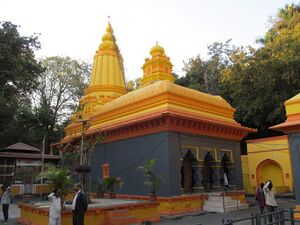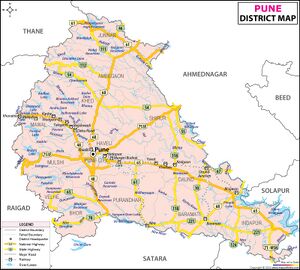Baneshwar
| Author:Laxman Burdak, IFS (Retd.) |

Baneshwar (बाणेश्वर) is a temple of Shiva located in the village of Nasarapur about 36 km southwest of Pune.
Variants
- Baneshvara (बाणेश्वर)
- Baneshwara (बाणेश्वर)
- Baneshvar (बाणेश्वर)
Location

Baneshwar (बाणेश्वर) Shiva temple is located in the village of Nasarapur about 36 km southwest of Pune.
History
It is a pleasant and calm place amidst a jungle. It was recently discovered and hence declared as a small bird sanctuary hosting a decent amount of rare birds with many Malabar grey hornbills seen.
Baneshwar temple architecture is from the medieval period. The temple was constructed in 1749 by Balaji Baji Rao, son of Peshwa Bajirao I. The total cost of construction was 11,426 Rupees, 8 Aane, 6 Paise. The temple hosts an important bell which was captured by Chimaji Appa after defeating the Portuguese in the battle of Bassien in 1739.[1] The bell has the year 1683 and a Cross on it, which depicts that the bell belonged to a church and was transported as a token of victory. Same kind of 4 more Portuguese bells can be found at Bhimashankar Temple, Omkareshwar temple- Pune, Shiva temple (Menavali-Wai) and Ramling temple (Shirur) too.
Katyayani Baneshvar temple, Benaulim, Goa
The village Benaulim (बेनौलिम) in Goa was known as Banahalli or Banawali (the village of the Bana) before the advent of the Portuguese. Ancient Banahalli was the site of the Katyayani Baneshvar temple (Katyayani = Parvati) dedicated to the deities Shiva and Parvati. The temple ruins can be still found in the village. The deities were shifted to Aversa in North Canara (modern Uttara Kannada district) in the sixteenth century.
Aversa Uttara Kannada
Aversa is a village in Ankola tahsil of Uttara Kannada, Karnataka, India.
Aversa Italy
Aversa (Italian: [aˈvɛrsa]) is a city and comune in the Province of Caserta in Campania, southern Italy, about 24 km north of Naples.
Prehistory: Although some archaeological sites excavated near Aversa have revealed human presence in the area since the Neolithic period, the first known inhabitants in the area were the Liburnians, people related to the Illyrians, whose territory was bounded on the south by Naples, west by the Tyrrhenian Sea and north along the Clanio river. However, some say that the founding of the city took place with the Etruscans. In any case, because of endemic malaria that ravaged the region, the primitive city was abandoned.[2]
Lower middle ages: Only a small military fortification, a castellum, still stands in the area, which is linked to a chapel in memory of the current alleged passage through Aversa by the Apostle Paul in the year 61. A.D., via the Roman road that ran towards Rome.[3]
Aversa, which replaced the nearby city of Atella that had been laid waste during the Gothic Wars, was the first of the Norman territories in the Mediterranean. In 1030, the site was ceded to Rainulf Drengot, a cadet of the lords of Quarrel near Alençon in Normandy; he was invested as count by Duke Sergius IV of Naples and confirmed by Emperor Conrad II. By offering a generous principle of asylum for the persecuted, Rainulf enlarged the power and importance of his little borgo, which became the base from which the Normans forged a state in Sicily and Italy. The diplomacy of Robert Guiscard, who built the fortifications, led to the investiture of a bishop responsible to the Pope at Aversa, which was nominally territory of the Eastern Emperor.[6] One of the first bishops was the Norman Guitmund (died c. 1090–95), a Benedictine monk, theologian, and opponent of Berengar of Tours.
The count of Aversa, Richard I, was one of the chief leaders in the struggle against the Papal forces which culminated in the Battle of Civitella del Fortore (1053) in Beneventan territory; even Pope Leo IX himself was captured at what turned into a rout in favour of the Normans. The astute Richard did not treat the pope as a prisoner, however, but escorted him back to Rome with full honours, a gesture that led to the conciliation of the Normans with the Church, the lifting of the ban of excommunication that had been laid upon Aversa.
External links
References
- ↑ https://templetiming.com/places/baneshwar-temple/
- ↑ Cecere, Aldo (2000). "Il nucleo originario". Aversa nella Storia e nell'Arte (in Italian).
- ↑ Cecere, Aldo (2000). "Il nucleo originario". Aversa nella Storia e nell'Arte (in Italian).

